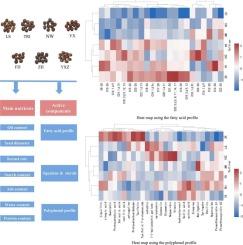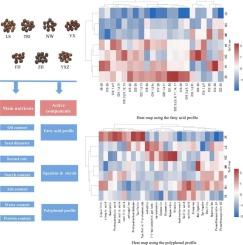茶籽作为新型功能性原料的潜力:主要营养物质和有效成分的综合分析
IF 9.8
1区 农林科学
Q1 CHEMISTRY, APPLIED
引用次数: 0
摘要
由于对茶籽化学成分的了解有限,制约了茶籽的开发利用。本研究综合分析了茶籽中的主要营养成分和有效成分,评价了茶籽作为功能性原料的潜力。茶籽的脂肪含量较高,而灰分、蛋白质和水分含量与葡萄籽相当,此外,茶籽的脂肪酸组成和多酚谱也同样优越。此外,还鉴定出了几个结实能力强、种子化学成分优越的茶叶品种。其中,山茶种子粒含量最高。分层聚类分析表明,中黄1号亚油酸(C18:2Δ9,12)、二十碳五烯酸(C20:5Δ5,8,11,14,17)和杉木素的含量高于其他6个品种。本研究不仅为茶籽功能性原料的开发提供了数据基础,而且为茶籽产业的发展找到了几个有前景的品种本文章由计算机程序翻译,如有差异,请以英文原文为准。


Potential of tea seeds as new functional raw materials: Comprehensive analysis of main nutrient substances and active components
The limited information regarding the chemical components of tea seeds hinders the development and utilization. This study comprehensively analyzed the main nutrients and active ingredients in tea seeds to evaluate the potential as functional raw material. The fat content in tea seeds was higher, while the levels of ash, protein, and moisture were comparable to those in grape seeds, additionally, their fatty acid composition and polyphenol profile were equally superior. Furthermore, several tea cultivars exhibiting stronger fruiting ability and superior chemical composition in their seeds were identified. Among these, seed kernels of Camellia sinensis cv. Zhonghuang 1 exhibited higher contents of linoleic acid (C18:2Δ9,12), eicosapentaenoic acid (C20:5Δ5,8,11,14,17) and taxifolin compared to the other six cultivars in hierarchical clustering analysis. This study not only provided a data foundation for the development of tea seeds as functional raw material, but also identified several promising cultivars for advancing the tea seed industry
求助全文
通过发布文献求助,成功后即可免费获取论文全文。
去求助
来源期刊

Food Chemistry
工程技术-食品科技
CiteScore
16.30
自引率
10.20%
发文量
3130
审稿时长
122 days
期刊介绍:
Food Chemistry publishes original research papers dealing with the advancement of the chemistry and biochemistry of foods or the analytical methods/ approach used. All papers should focus on the novelty of the research carried out.
 求助内容:
求助内容: 应助结果提醒方式:
应助结果提醒方式:


